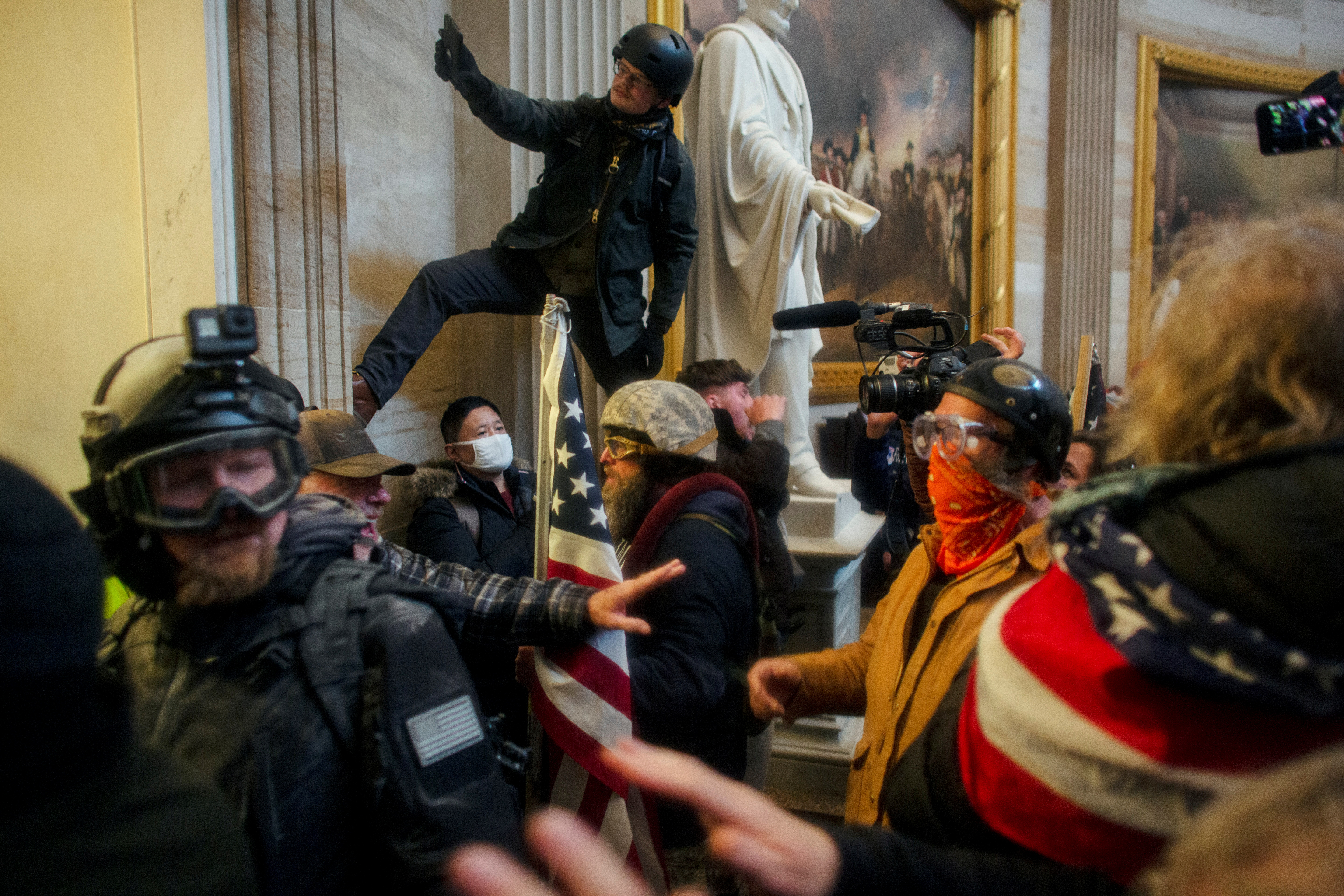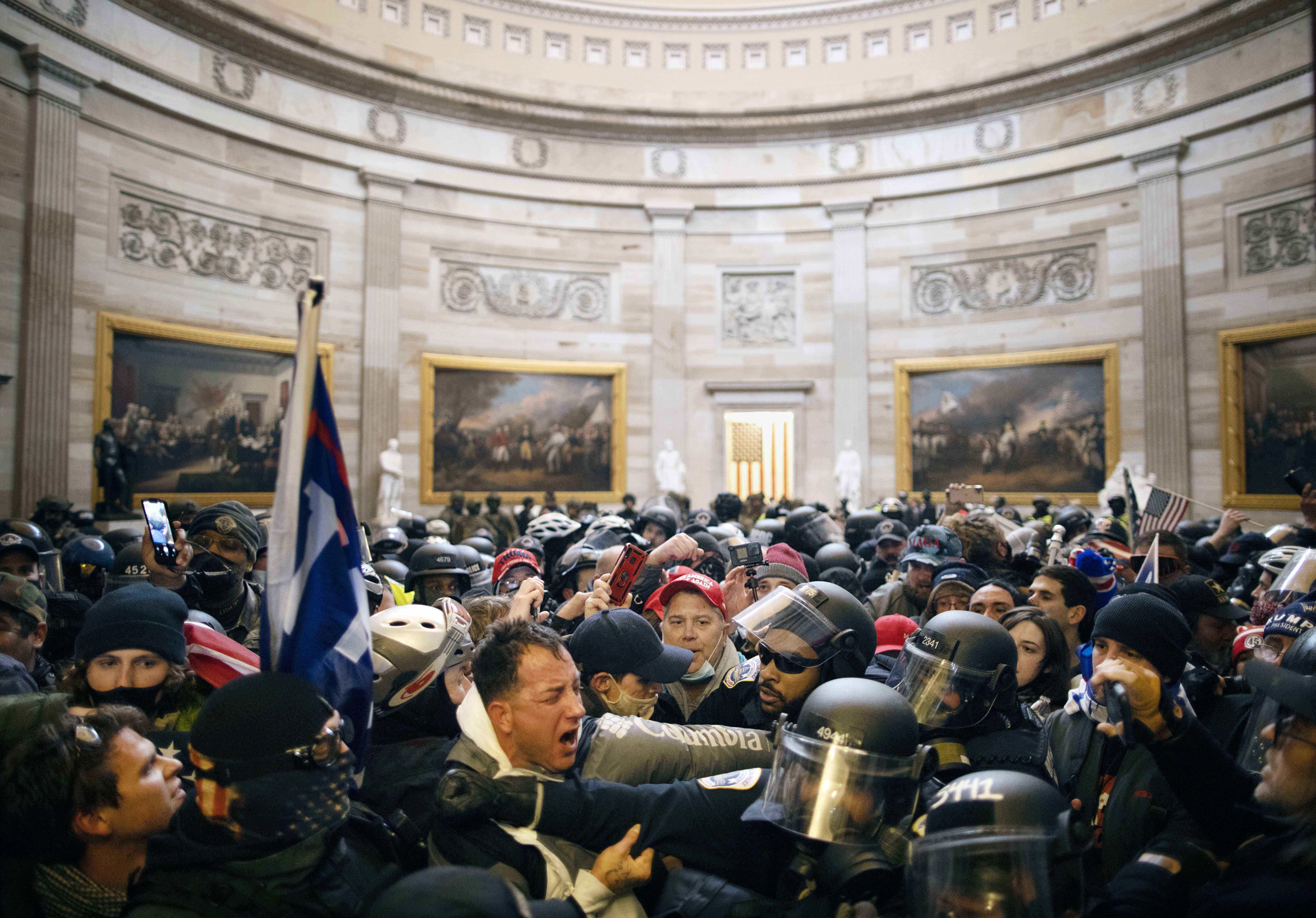The insurgency at the United States Capitol on January 6, 2021 was a monumental act with multiple intent. The Capitol is, after all, a monument, perhaps the monument of monuments, combining historic significance and the seat of legislative power. The January 6th insurgency of white nationalists responded to the removal of racist statues since the George Floyd Uprising with a mediated and visible affirmation of its power. Its self-appointed mission was an act of domestic counterinsurgency, because, in their view, the election result was a false imposition on what they called “America,” meaning their world view. Like the US Army in Vietnam, this counterinsurgency had to destroy the Capitol in order to save it.
In 2017, the Unite the Right rally at Charlottesville was a defense of Confederate statues as the symbolic infrastructure of white supremacy. Four years later, the Capitol insurgency aggressively claimed the capacity to reconstitute power itself by forming a digitally mediated variant of “we, the people.” This people is the “America” that should rule. The Capitol monument action was both the site of the claim to this constituent power and the platform by which it was disseminated. The insurgency failed only its attempt to create a new form of constituted power by overturning the presidential election.
To clarify these terms, in a settler colony, power is constituted by the claiming of dominion by adverse possession. The forcible claim to constituent power is then formalized in a constitution, granting constituted power. In this case, the American Revolution first declared independence, claiming constituent power. After defeating the British to gain dominion, it issued a Constitution enabling the operation constituted power. The Capitol both memorializes those actions and is the site of their ongoing practice.
‘We, The People”
“Storming the Capitol,” as the insurgents called January 6th, as if it were a performance (and there will, of course, be a movie) was a self-conscious reenactment of the American Revolution, defined by exclusion. While many saw its affiliations with the Live Action Role Playing craze, its roots lie in Civil War reenactment. At such events, the insurgents had long practiced the overturning of history, just the highest form of fake news (as they see it), in line with their understanding of the US Constitution as a supremacist document, a view many on the left share, while drawing very different conclusions. 1

January 6th was an assertion of constituent power for the digital age. It was endorsed by its watching audience online and on television, in the same way that the invited audience and spectators endorse a coronation or inauguration. For this function of the insurgency, the much-derided selfies and live-streaming were the point, not a sideshow or freak show. The livestreamed “people” depicted themselves to themselves and their audience as the newly and properly constituted form of “we, the people.” In the live streams and video stories, insurgents loudly and persistently claimed to be America. 146 elected representatives voted later that day in support of this constitution of “we, the people.”
Analyzing the still photographs—all themselves technically a breach of Capitol rules—almost every insurgent can be seen with their phones out, whether taking photographs, video or livestreaming. Some of the best prepared insurgents had helmet-mounted cameras above their tear gas protection goggles to protect them. In order to get a clear view of the struggle to break out of the Rotunda to the House of Representatives, as Ahmed Gaber’s photograph shows, one livestreamer jumped up on Vinnie Ream’s 1871 statue of Abraham Lincoln, while propping his other foot against the wall of the Rotunda. The movement enacted the transformation of the monument, its digital stream rising on the ruins of the physical shell.

These dramas were condensed into the simple slogan “1776,” chanted inside and outside the Capitol that day. This “1776” is not the narrative already monumentalized at the Capitol. Consider those widely-photographed scenes of insurgents in the tear-gassed Rotunda. Through the sfumato of the gas, John Trumbull’s oversized paintings of the American Revolution can be seen hovering in the background, as in Mostafa Bassim’s photograph here. Two moments of British surrender emphasize American military dominion, while facing paintings of the Declaration of Independence and Washington resigning his commission showed how this power was then formally constituted. The insurgents ignored all these scenes of white supremacy.2 They used the statues as coat racks and dragged excrement around the building like burglars.
After the Occupation

This new variant of “we, the people” was energetically promoted by the Trump administration in material and ideological forms, with an eye to continued disruption in the future. First, it announced plans for a sculpted National Garden of American Heroes. This bronzed fantasy sought to combine the monument with the Garden of Eden and Thomas Carlyle’s nineteenth-century colonial legend of the Hero as the “great man” who makes history. Despite the peculiar selection, ranging from German Jewish philosopher Hannah Arendt to Canadian game show host Alex Trebek, these heroes were to have memorialized the worldview of “we, the people” on January 6th.
On the very last day of Trump’s term, what amounted to the insurgents’ doctrine was published in the report of the 1776 Commission. In this widely and deservedly pilloried document, deleted within hours of the new administration taking office, the removal of monuments was held up as the result of “anti-American” thinking:
Deliberately destructive scholarship … is the intellectual force behind so much of the violence in our cities, suppression of free speech in our universities, and defamation of our treasured national statues and symbols.3
In this new McCarthyism, academics like myself are supposed to be behind everything from the George Floyd Uprising, to the removal of Confederate monuments and flags.
Strike the Monument!
How should those committed to abolitionist and anti-racist work respond?
It’s time to mobilize what David Graeber and Stevphen Shukaitis have called “the constituent power of lived imagination.”4 To see how to do so, look south. In 2019, a strike over transport costs in Chile unfolded into a challenge first to monuments, as Mapuche people took down the statues of conquistadors; and then to the constitution inherited from the fascist era of General Pinochet. A referendum earlier this year to call a new constituent assembly was successful. Taking down monuments was a necessary part of changing constituent power because constitutions are monuments to that power.
Which entails a new consideration of power itself. The feminist strike in Argentina that brought about the legalization of reproductive rights in 2020 set aside the Spanish poder, meaning “static, constituted power,” such as that in the state and the statue. It adopted instead the word potencia which has a “dynamic constituent dimension…our power to do, to be affected and to affect others.”5 For activist scholar Verónica Gago, the strike is a “lens,” or way of seeing, through which to both analyze and take practical action: “mapping the strike thus becomes a tool for visibilizing hierarchies.”6 This potencia of the strike is situated, feminist and connected as a “practical cartography” of counter-power. Instead of rushing to make new monuments, first make a new way of seeing power and countering existing power.
